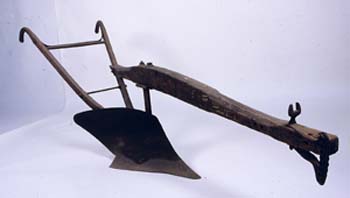Technology in Illinois Agriculture

Illinois State Museum Collection
This section of the web site will follow the changes in technology in agriculture in Illinois from 5,000 years ago to today — from bison scapula hoes of Native Americans to great combines of today. It will also explain some of the cultural changes that have taken place as a result of these technological changes. These ideas will be illustrated by the Museum's collections of Botany, Decorative and Industrial Arts, Art, and Anthropology and Archaeology, and by oral histories of farmers.
In 1820, settlers used hand tools and wooden plows to farm their few acres. By 1850, steel plows and steam engines were doing much of the work. By 1880, Illinois inventors and industrialists were making a multitude of improvements and innovations in farm machinery. From the second quarter of the twentieth century, fertilizers, pesticides, herbicides, and medicines radically changed the management of the farm.
Transportation system developments and improvements also dramatically changed the marketing of farm commodities. Refrigerated freight cars increased the distance fresh produce and meat could travel to markets. Dams and dredging improved the navigability of rivers. Drainage tile systems expanded acreage available for farming.

Illinois State Museum Collection
The Museum’s collections of nineteenth-century farm tools and machinery
and patent models illustrate the history of technological development and
manufacture in by Illinois companies. Many of the world-famous agricultural
machines, such as the John Deere Plow, were first invented and made in Illinois.
The Museum’s historical photograph collections show farmers using some
of these traditional and ‘new” machines and tools, teaching us
about tools and processes that have disappeared, and giving us an appreciation
of the contributions of those farmers.







